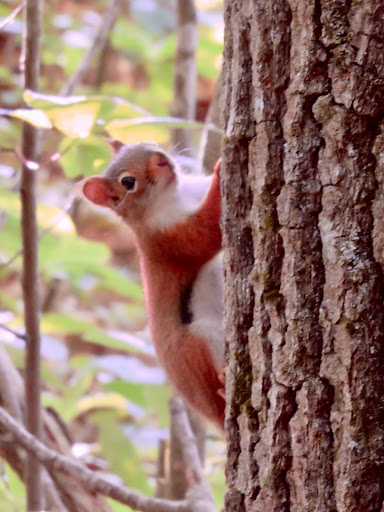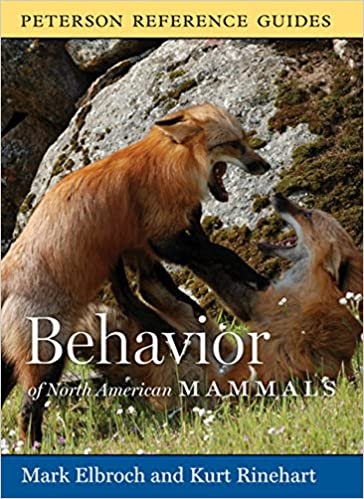This week’s goal was to photograph buds and bark. While doing so, an unanticipated subject caught my attention. Whether it was the chirp or the rapid movement, I can’t recall. By the time I redirected the camera, the creature had travelled through three trees and, fortunately, settled on a limb to watch me.

In our region, the vocal and energetic red squirrel is smaller and less common than the gray squirrel, for its preferred diet of conifer seeds can be better satisfied in the great boreal forests of the northern U.S. and Canada. In southeastern Massachusetts, it lives in mixed deciduous/coniferous woodlands. My new acquaintance was perched on an eastern hemlock, a tree that bears small seed-bearing cones. Several hemlocks, including this tree, grow near Queset House, as do some eastern white pines with their much larger cones.
This simple image conveys some aspects of the animal’s life history. Like gray squirrels, the red squirrel is diurnal, active during the day. It is supremely arboreal: it snips cones from branch tips, it travels over branch “highways,” and it utilizes vacant tree cavities for shelter. Its anatomy enables it to climb up and down tree trunks and to balance on fine branches. The prominent tail helps with balance, and, according to The Peterson Reference Guide to Behavior of North American Mammals by Mark Elbroch, its hind feet “can swivel . . . 180° to the rear,” which, apparently, is helpful when descending headfirst.
In appropriate habitat, it is easy enough to see red squirrels foraging in trees. Another common sign of their presence are middens, that is, piles of cone scales left behind after feeding. Red squirrels tear the scales from conifer cones in order to reach the seeds beneath them. The squirrels often feed in the same place; consequently, the inedible scales and cone shafts accumulate into noticeable piles below favorite perches or at feeding stumps.
In addition to conifer seeds, the red squirrel’s diet includes nuts, fruits, mushrooms, sap, bird eggs, and tree buds [Elbroch, pp. 269-271]. There were no pine cones where I saw the library’s red squirrel, but there were plenty of black walnut shells -- with husks removed and meat extracted. Such a meal requires strong jaws, sharp teeth, and determination.

You may also observe red squirrels at your backyard feeder where they consume and collect seeds. In autumn, this foraging behavior intensifies as the squirrel stockpiles food for winter, building one or several caches of provisions. These stores, which are crucial to the red squirrel’s survival, are defended by their territorial owners.

To survive winter, the red squirrel needs its cache, an insulated nest, and a safe way to move between the two. The caches, according to Donald Stokes, may be located “under tree roots or in underground burrows.” The nest may also be underground or in a tree cavity or between branches. Part of “the route” is provided by the canopy of interlocking tree branches. When there is snow cover, the red squirrel may tunnel a sheltered route through the snow to connect its food and nest. As a small prey animal, this species is ever alert to hawks, weasels, foxes, and other predators -- hence, the frequent alarm chirps and rapid retreats.
When you see red squirrels this winter, observe the paths they take. You may see tracks, though this species prefers the safety of trees. Moreover, be on the lookout for middens and for snipped evergreen branches on the ground. As you will learn from Tracking and the Art of Seeing, these “nip twigs” reflect the squirrels’ habit of nipping off small branches in order to eat the terminal buds. The unused portion of the twig is dropped to the ground. If all else fails, keep your ears peeled, for you are bound to hear the squirrels as they spot you!

At the Library
Behavior of North American Mammalsby Mark Elbroch
[Commonwealth Catalog]
Tracking and the Art of Seeing: How to Read Animal Tracks & Signby Paul Rezendes
by Donald Stokes

